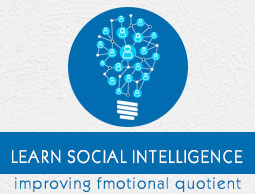
- Social Intelligence - Home
- Social Intelligence - Introduction
- Social Intelligence - Applying
- Socially Intelligent People
- Body Language Worksheet
- Emotional Quotient
- Emotional Quotient-Questionnaire
- High Social Intelligence
- How Socially Intelligent Behave
- Effect of EQ on Listeners
- Empathy as a Managerial Tool
- Social Intelligence - Organizations
Social Intelligence - Quick Guide
Social Intelligence - Introduction
With the advent of 20th century, people started believing in the fact that there are no two individuals who are born exactly identical. When we say identical, it means both physical features and thought process. There was a time when people used to tell their children to be like their idol who could be their favorite player or athlete. However, now it has been universally accepted that asking someone to be somebody else is not only is an unrealistic and impractical demand, but also is a disastrous practice to follow, especially for children, as it stunts mental growth and creative thinking in people.
Two individuals are born distinct from each other, and are different in their ways of thinking and interpreting the world. Asking them to be someone else could prevent the growth of their own distinct personality. While this factor of humans to be born unique and different gives us the wide variety of personality traits and approaches, it is the same factor that is the reason behind difference of opinions.

Even with our difference of opinions and unique ways of looking at problems, we cannot deny the fact that we are all social beings and we have to interact with others around. We need to grow and relate to others for growth, knowledge, awareness, and survival. This process of interacting with different people teaches us the essential skill of adaptation. We learn to make adjustments in our lifestyle by relating to other people. We need to adapt constantly under various situations to sustain and maintain our relationships. Our self-confidence, self-esteem, and self-awareness are all influenced by our interactions with other people.
What is Social Intelligence?
Social intelligence can be defined as the human ability of decoding the happenings of the world and responding to it likewise. This ability is exclusive to humans and distinguishes us from the rest of beings in the animal kingdom.
Social Intelligence is also the capability to act wisely while maintaining human relations. It is markedly different from just intelligence, unlike what people used to think earlier. Over the years, it has been observed that many exceptionally intelligent people struggle a lot while maintaining a social life.
An immediate example that springs to the mind is that of Kim Peek, whose life had inspired the hit movie Rain Man. Peek had an exceptionally sharp memory that allowed him to literally scan through books reading two pages at a time, with his left eye reading the left page and the right eye going through the right page simultaneously. This technique allowed him to browse through books at incredible speeds and what he read, he remembered permanently. Last checked, he was about to recall paragraphs from over 12,000 books. However, he was socially inept and avoided human interaction for a major part of his life. His communication was, for the most part, limited to his father.
Examples such as these prove that even exceptionally intelligent people need not have the same levels of social intelligence too. Social Intelligence is different from academic ability and signifies the talent of getting along with other people, as compared to solving equations and having well-defined learning mental facilities. As per the recent definition, Social Intelligence is an individuals collection of knowledge and facts about the outside world. This can be influenced by factors like self-confidence, and a desire to meet new people.
Types of Intelligence
According to experts, there are three types of intelligences −
Abstract Intelligence − It is the ability of applying knowledge in complex problem-solving by seeing the problem as a whole as opposed to checking only the individual, constituent parts. This is about understanding the non-verbal ideas and expressing them verbally. They are assessed as a part of Intelligence Testing.
Mechanical Intelligence − It is the skill to understand the functioning of mechanisms and processes. Engineers and scientists have a typically high level of mechanical intelligence that enables them to understand how a machine works or what would make a specific machine work.
Social Intelligence − This kind of intelligence is found in successful managers and marketing people. They know how to find their own in a group of people and they are always ready with proper responses to every query. In other words, they know how to be the peoples person.
Social Intelligence is also known as interpersonal intelligence because it is also the study of an individuals ability to notice the distinctions between him and other people. As per this concept, a persons own unique personality is a product of the persons difference in knowledge on different areas as well as the level of social interactions he has with the people in his surroundings.
Importance of Social Intelligence
Industry experts have confirmed that thousands of employees have recently lost their jobs due to their lack of social incompetence. Earlier, talented people thought they only have to be good at their jobs to guarantee their place in a company. However, the recent change in business approach has made all these employees rethink their style of working. They now realize that they cant be employees in desk-jobs, and have to start taking a larger interest and part in the improvement and growth of the organization.
Technology has made people self-centered, in the sense that people might be interacting with people online happily, but the same people will be ignoring those sitting beside them. This boundary that people have drawn around them makes them look isolated and uninterested in any real-world communication, making the lack of human communication and relationships a pressing problem of our times.
It is no surprise then that people having better social skills have more friends, are in more relationships, and know how to nurture a relationship. This leads them to have successful careers and generally happier lives.

We live in a society and come in contact with people with different thoughts and personalities every day. While meeting these people with different social and psychological characteristics, we experience happiness, sorrow, misunderstandings, agreements, quarrels, and other different emotions. If we dont know how to handle these feelings, we will tend to avoid those people who make us feel uncomfortable. That in turn, will make us appear unfriendly to those people, many of whom could be important people in our lives.
Social Intelligence - Applying
EQ and IQ
We are all familiar with that one employee whom we know as a really talented and hardworking who will never get promoted. We know that he is intelligent but something tells us that he will never be a manager. Those qualities that we think are missing in him are called social skills. These are the skills or traits that have nothing to do with someones individual intelligence but everything to do with their success.
Psychologists have started terming this as Emotional Quotient (EQ) and frequently compare its role in the improvement of human beings, with respect to Intelligence Quotient (IQ). According to them, while a persons IQ tells us his levels of intelligence and information-processing speed, its a persons EQ that puts him in control of his feelings and teaches him to handle complex situations. It has become a wide practice to use EQ as an evaluation tool for job applicants because companies know that simply hiring people based on their talent and skills only will not get them employees who will understand the working culture of the company.
Social Intelligence teaches people the skills of addressing individual differences positively, instead of avoiding them and running away from them. In large organizations, processes will cease to function properly if people started having issues while working with one another. Effective conflict resolution, successful negotiation and enhancing personal and professional relationships are all the foremost objectives of Social Intelligence.
Social Intelligence makes us more adaptive to our social environment and be flexible as per the needs of the people in our surroundings. Being flexible means understanding the issues the other person is facing and seeing if its possible to make any change in your schedule so that you benefit, while being in total command over the choice you are going to make. This is different from passively agreeing to others whims, where you dont have any control over the actins you are partaking in. Being flexible increases your understanding power and helps you develop smooth and productive working relationships with co-workers.
Social Intelligence in Zappos
A good example of companies practicing Social Intelligence is Zappos, an online shoe and footwear apparel shopping site. As Tony Hsieh, the CEO of Zappos.com would tell you, "If you get the culture right, then most of the other stuff, like great customer service or building a brand will just happen naturally." The company has internalized ten core values that they say, define the working culture at Zappos.com.
Interestingly, its not the CEO, but the employees themselves who decide what the companys culture should be and how it should evolve. The managers at Zappos.com strive constantly to deliver a working environment for their employees that gives them ample freedom and space. According to Hsieh, the company selects candidates for jobs based on how much they can formalize the companys culture. He says, Weve actually passed on a lot of really talented people that we know would make an impact to our top or bottom line, but if you know theyre not a culture fit we wont hire them.
There are cases of people working with Zappos.com who were fired even if they were doing their jobs perfectly if they were found to have not worked as per the companys culture. The companys ten core values are seen in effect in everything the company does. Likewise, he explains the company will fire people even if theyre doing their job perfectly if theyre bad for the culture.
Zappos Family has ten core values to more clearly define what exactly the Zappos Family culture is. They are −
- Deliver Wow through Service
- Embrace and Drive Change
- Create Fun and a Little Weirdness
- Be Adventurous, Creative, and Open-Minded
- Pursue Growth and Learning
- Build Open and Honest Relationships with Communication
- Build a Positive Team and Family Spirit
- Do More with Less
- Be Passionate and Determined
- Be Humble
If you observe closely, you will realize that the qualities the people at Zappos.com are actually formalizing in their company are all those that enhance a persons Social Intelligence. The reason this is so important in their organization is because they have seen that people with a well-developed EQ are more successful at the workplace.
People with high social intelligence understand the emotions of other people and are also able to control their own emotional responses to these situations. They can know why people behave the way they do. They understand different points of view and know how to respond to conflicting situations with calmness and composure. These qualities make a person an ideal employee and this why people who compete for jobs realize that social intelligence cannot be taken for granted. It brings balance and a sense of perspective in ones life and thus, is very essential to the growth of individuals.
What would be the benefit of improving the social intelligence of employees in an organization? Sample this. After integrating a six-month training process called Emotional Intelligence for New Managers to their training program, FedEx reported an 8-11% increase in core leadership competencies. Over half the participants have shown very large (10-50%) improvements in their emotional intelligence skills, like leadership abilities. 72% of the program participants are exhibiting tremendous improvement in their decision making skills, over 60% report a better quality of life and 58% show much-improved decision-making skills.
Socially Intelligent People
Daniel Goleman has stated in his book Social Intelligence that the worst side of human nature is the toxic form it can take by just being around the wrong person at the wrong time. This extremely popular book was influential in bringing a sea of change in the way companies viewed the roles of employees in the company.
Employees were earlier treated and looked as service-providers, however, now the employees are treated like an organizations key assets. These changes have come due to the companies adopting the applications of Social Intelligence in their day-to-day lives in workplace.
According to SI experts, no two humans have an identical interpretation of the same word. The word car might bring the mental image of a Barracuda for someone, while someone else could imagine an Aston Martin. Human beings respond to words through the inputs they get and their own sensibilities.
In many situations, the messages are sent via postures, movements, gestures, facial expressions and tone of voice. For example, if you were to walk into a conference room where a meeting is on the way, you can easily be able to figure out who the influential people are and who are the subordinates by simply observing their way of sitting, the way people respond to them, the way someone stands or maintains eye contact, etc.

The manner in which a person can influence others through his physical appearance, mood, body language, even the space he occupies in the room has a bearing upon the others and are clues to the way the person desires to be talked to, listened to, and respected.
Many tend to believe that only good looks and good clothes are sufficient to send a suitable message across, however the physicality of a person bears huge significance on the way he portrays emotions of friendliness, effectiveness, assurance, kindness and empathy. They need to project an inviting personality that dispels the initial hiccups in the mind of a person while approaching them.
When people sense hostility or are themselves unwilling to accept a decision, they start sending subtle, sometimes obvious, signals through their body language. These signals are found to be in direct conflict to the put-on neutrality they try to portray in their speech. People are quick to observe if a person has a salesman smile, i.e. insincere smile where he is trying to be too friendly, as opposed to the normal behavior.
Putting it differently, you could say that the person will give off the air of not being authentic. Authenticity is different from being merely honest and true. An authentic person is someone who also portrays genuine emotions for people and wants to really help others. Just having a good smile and good personality is not sufficient if a person is not authentic. Therefore, a person who has good social skills might not be able to impress upon people if he is not socially intelligent.

Socially intelligent people also know the difference between people who are genuinely hurt, and those who are looking for an excuse to make you feel bad for hurting them. These people have low self-esteem and love playing the victim card. They believe that by complimenting others, they degrade themselves, hence they enjoy making people fall for their guilt trap. For example, if you confront these people on their poor performance, then these kind of people will often come up with a left-handed comment like, how could you say that after all that I have been through in my life recently?, clearly trying to attach their issues in family life to their drop in productivity at the workplace.
A socially intelligent person knows that empathizing with them is just feeding to their negative self-esteem, hence he will steer clear of getting too involved in giving suggestions to them. On the contrary, he will stick to the point and send polite reminders about the work that needs to be done.
Body Language Worksheet
This is an interesting activity to organize in your company, especially if you are working in a diverse workplace. Try to get as many people from different backgrounds, countries, races and social circles as possible. Arrange them to sit in a circle where they can all see one another. Now, give them a printout of this worksheet and ask them to answer the questions −
| S.I. | Non-verbal Actions | Interpretations |
|---|---|---|
| 1. | Smiling | |
| 2. | Smiling with raised eyebrows | |
| 3. | Rolling eyes with smiling | |
| 4. | Rolling eyes without smiling | |
| 5. | Shrugging shoulders while answering a question | |
| 6. | Shrugging shoulders while asking a question | |
| 7. | Stretching your arms sideways while speaking | |
| 8. | Looking down while saying something | |
| 9. | Hand held up with palm facing you | |
| 10. | Hands with palm facing down while explaining | |
| 11. | Waving to someone | |
| 12. | Tapping someone on the shoulders | |
| 13. | Holding someones hand | |
| 14. | Standing close to someone | |
| 15. | Winking at a friend | |
| 16. | Crossing arms while taking feedback | |
| 17. | Shaking hands without a firm grip | |
| 18. | Yawning while listening to someone | |
| 19. | Drumming table with fingers, waiting for lunch | |
| 20. | Placing hand over mouth on hearing something | |
| 21. | Swinging feet and tapping feet to music | |
| 22. | Crossing legs while in a meeting | |
| 23. | Nodding the head up and down while listening | |
| 24. | Turning the head side to side while listening | |
| 25. | Whistling while walking alone | |
| 26. | Clapping on listening to something | |
| 27. | Scratching your head when asked a question | |
| 28. | Showing an outstretched palm to a speeding car | |
| 29. | Wagging one foot while keeping it on a knee | |
| 30. | Raising hand inside a classroom | |
| 31. | Looking elsewhere when someone talks to you | |
| 32. | Keeping hands in your pocket while talking | |
| 33. | Rubbing the neck when asked about something | |
| 34. | Cracking fingers while at work | |
| 35. | Looking around waiting in the reception area |
Social Intelligence - Emotional Quotient
When the concept of Emotional Intelligence was first introduced to a wide audience in 1995, it quickly dawned upon the companies that the qualities that were traditionally associated with leadership, like intelligence, determination, and being well-informed were not sufficient in order to succeed in the fast-changing business scenario.
People started realizing that only Intelligence Quotient is not sufficient to run a business successfully. In order to have a sustainable business, its always very important to keep interacting with your customers. In other words, businesses woke up to the concept of Emotional Quotient.

Experts identified a few core competencies that enhanced an individuals Emotional Quotient and his aptitude for successful business. They are as follows −
Self-awareness − This is the ability to recognize your feelings and understand your emotional reactions, and how they influence your behavior and performance. It helps people get an idea of the perception they create in other peoples minds. A self-aware person is both confident of his own abilities and mindful of his current limitations.
Handling emotions − People who know how to manage their feelings can keep calm under tremendous emotional pressure. This is essential to develop as a responsible employee who doesnt shirk away from being held accountable for the teams performance. This prevents them from taking hasty decisions which they might regret later.
Self-motivation − The ability to motivate yourself in face of adversity is the hallmark of a perseverant individual. People who can put a positive spin on their negative emotions and end up as performers are prized in organizations.
Empathy − Empathy is the quality of putting yourself in other peoples shoes and knowing where the shoe pinches. Understanding the problems of others by thinking of them as your own will not only help you in earning their respect but also taking a just decision.
Resilience − In todays world, resilience is a very important quality to have. Someone who can beat all the odds through his perseverance is a winner all the way. A resilient person can adapt to a changing environment and have a broad vision to understand the trends that are going to be followed.
In a recent study, it was concluded that leaders who use their Emotional Quotient to foster a sense of caring and engagement with their teams deliver significant bottom-line results. Teams with higher engagement are −
- 50% more likely to have lower turnover (work gets done faster)
- 56% more likely to have higher-than-average customer loyalty
- 38% more likely to have above-average productivity
- 27% more likely to report higher profitability
Emotional Quotient-Questionnaire
This self-assessment questionnaire is designed to engage you in finding out your key emotional intelligence traits and your Emotional Quotient. Try to stay as emotionally neutral as possible while you attempt this questionnaire; your selection of answers will change depending on the mood you are in while answering the questions.
Score 1 = Statement never applies to you.
Score 3 = Statement sometimes apples to you.
Score 5 = Statement always applies to you.
| S.I. | Statements to Consider | 1 | 2 | 3 | 4 | 5 |
|---|---|---|---|---|---|---|
| 1. | I immediately know when I become angry. | |||||
| 2. | I can handle bad situations fast. | |||||
| 3. | I am self-motivating. | |||||
| 4. | I see the problem someone faces from his point of view. | |||||
| 5. | I have good listening skills. | |||||
| 6. | I know when I am in a good mood. | |||||
| 7. | I have a control on my emotions. | |||||
| 8. | I can prioritize between a set of important tasks. | |||||
| 9. | I easily empathize with others when I listen to their issues. | |||||
| 10. | I always let other complete their sentences before I speak. | |||||
| 11. | I like knowing new people and making new friends. | |||||
| 12. | I realize when I am feeling stress. | |||||
| 13. | Others find it difficult to know my mood. | |||||
| 14. | I am good at meeting deadlines. | |||||
| 15. | I immediately know when someone is unhappy with me. | |||||
| 16. | I am good at meeting with different type of people. | |||||
| 17. | I can recognize my emotions. | |||||
| 18. | I rarely lose my temper when dealing with difficult people. | |||||
| 19. | I always utilize time. | |||||
| 20. | I can tell when people are not getting along well. | |||||
| 21. | I like interacting with people and talking to them. | |||||
| 22. | I can know when and why I am anxious. | |||||
| 23. | I dont get annoyed with difficult people. | |||||
| 24. | I do not give ambiguous messages or signals. | |||||
| 25. | I realize when people start being unreasonable with me. | |||||
| 26. | I realize when I am being difficult. | |||||
| 27. | I can change my mood when I want to. | |||||
| 28. | I always do the most difficult work first. | |||||
| 29. | I realize that people will have different working styles. | |||||
| 30. | I need interesting colleagues to make my job interesting. | |||||
| 31. | I always like to be aware of my emotions. | |||||
| 32. | I dont let stressful situations affect me or my work. | |||||
| 33. | I like bigger rewards later compared to small, instant ones. | |||||
| 34. | I realize immediately if I am being unreasonable. | |||||
| 35. | I like to ask questions to people to understand them. | |||||
| 36. | I speak out if someone has upset or annoyed me. | |||||
| 37. | I rarely worry about life or work. | |||||
| 38. | I believe in instant action. | |||||
| 39. | I realize the reasons behind my action hurting people. | |||||
| 40. | I look at working with difficult people as a challenge. | |||||
| 41. | I can quickly control and manage my anger. | |||||
| 42. | I can suppress my emotions as per my will. | |||||
| 43. | I can motivate myself for better things while struggling. | |||||
| 44. | I can understand things people are trying to tell me. | |||||
| 45. | I am good at ending differences with others. | |||||
| 46. | I can describe things that make me happy. | |||||
| 47. | Others dont realize how I am feeling. | |||||
| 48. | Getting motivated has made me successful. | |||||
| 49. | I always know the reason that started the disagreement. | |||||
| 50. | I build strong relationships with those I work with. |
In the following table, you need to put down the scores you gave yourself against that specific question number. For example, if the score you gave in response to statement number 1 was 5, then write 5 beside 1. Complete the table and tally the totals for each column at the end of the table.
| Self-awareness | Handling Emotions | Self-motivation | Using Empathy | Practicing Resilience | |||||
|---|---|---|---|---|---|---|---|---|---|
| Scores | Scores | Scores | Scores | Scores | |||||
| 1 | 2 | 3 | 4 | 5 | |||||
| 6 | 7 | 8 | 9 | 10 | |||||
| 11 | 12 | 13 | 14 | 15 | |||||
| 16 | 17 | 18 | 19 | 20 | |||||
| 21 | 22 | 23 | 24 | 25 | |||||
| 26 | 27 | 28 | 29 | 30 | |||||
| 31 | 32 | 33 | 34 | 35 | |||||
| 36 | 37 | 38 | 39 | 40 | |||||
| 41 | 42 | 43 | 44 | 45 | |||||
| 46 | 47 | 48 | 49 | 50 | |||||
Total |
Total |
Total |
Total |
Total |
|||||
If score between 35-50 This area is your strength
If score between 18-34 You need to improve in this area.
If score between 0-17 You need to give immediate attention to this.
High Social Intelligence
According to Eric Berne, people who have had neglected, abused, or generally bad childhoods have trouble in building relationships or having self-esteem. These people feel neglected even in their adult life and their sense of low self-esteem prevents them from having an honest, frank, and direct interaction with anyone.
What these people do is manipulate other peoples emotions and make them do what they want when they could have achieved the same results just by asking politely. Identifying these people is the first step to building a good taskforce. People with high emotional intelligence, on the other hand, will always have a strong elevator speech to describe or introduce any idea to people.
They always know how to put important concepts, ideas, or situations in front of others in a concise, clear, and objective manner. This helps them in putting an honest impression in the minds of their listeners, while bringing the focus on the task in hand. At a time when getting more messages across consistently is becoming the need of the hour, having the skill of making efficient and specific communication with others is a big advantage.

Another ability that people with good social intelligence have is to be able to use language that can express tough feedback and criticism in a more palatable manner. Nobody generally likes to face criticism, as they consider it to be a judgment on their efforts. So an employee needs to be properly conditioned to accept criticism in a positive manner, however giving criticism in a positive manner in itself is an art that requires great practice and right choice of words.
How Socially Intelligent Behave
Socially intelligent people have the ability to know how to monitor their language in such a manner that it avoids any conflict in the minds of the listeners. They can identify words that might create misunderstanding and steer clear of these ambiguous words.
They also realize that certain words tend to intimidate and threaten people. They avoid the usage of such words, especially while sharing feedback on the peoples performances. They do it through their skills of empathy and being open-minded towards peoples queries. For example, instead of using you statements, they focus more on using I statements.
Sample the following conversations −
Case 1 Team Manager to employee − "You are always coming late and giving excuses. Your output has been very low this month and your performance is nothing to write home about. You have not delivered anything last month and now you face termination from the company."
Case 2 Team Manager to employee − "I am concerned about how I am going to put good numbers on the board this month, as I havent yet received the productivity that I was expecting. I am also thinking seriously about the punctuality issue of our team and how that is making us lose productivity. The performance of our team last year was also not satisfactory and I am under pressure to trim off those from the team who are not pulling their weight.
Of both the cases, which one do you think will get the message across and prevent any negative personal backlash? Which case would get the employee start thinking without feeling bad about his performance being pointed out to him?
A person with Social Intelligence knows that using the I statements will show the employee the issues that the manager is facing and what he is forced to deal with, and also makes the person being spoken to sensitive to the issues. Using neutral language will send a positive signal of mutual respect to the listener and a willingness to acknowledge a different point of view.

As you can see, the changes that you are to bring in your speech are not vast. Its just the change of one word in the previous example that set off a completely different course of conversation and interpretation. For example, many language specialists say that using the word but signifies a precondition to an action.
In the sentence, I will help you, but you have to wait for just a few minutes. signifies a precondition that help will only be provided in case you are patient. However, substituting the but with and will make the sentence sound different. Try it yourself −
I will help you, and you have to wait for just a few minutes.
People who havent acquired clarity in speech tend to speak in a cluttered, rambling manner which clearly suggests that they havent yet learnt how to process and filter their thoughts. A carefully constructed conversational strategy requires the proper usage of words and also the proper intonation.
Influencing others needs information to be presented in such a manner that can be easily processed. Its also important to present the right picture. Before giving a statement, its always advisable to ask yourself − Do you say what you mean and mean what you say?
Effect of EQ on Listeners
The human brain can process 500 words in one minute of speech, however most people have a rate of speech of only 150 words per minute (WPM). This means, we have a dead-air in our speech that occupies the time of 350 words. Its interesting to note that the people who are considered to be attention-grabbing and persuasive are those who can utilize this dead-air time in such a way that the listener doesnt get an opportunity to get distracted by any other input.
Dropping one shoe is one of the methods that skillful talkers use to set up the expectation of what the listeners are about to hear. This is an effective method of conditioning people properly so that they can get themselves prepared for some news or information that they otherwise would have felt shocked in listening. It involves a rather simple technique of asking a provocative question in the beginning of the presentation.
While the listeners are now thinking of the various possibilities of answers of that questions, you start discussing key points that give a clearer picture on the posed question. These points must be arranged in a sequential manner and must lead to the final picture by dropping knowledge in the right places for people to be able to draw a clear idea. The listener who at this point is thinking about the question, and is looking for an answer will automatically be drawn towards the presentation in his search for an explanation. This increases attention-retention and the message gets clearly absorbed too.
Telegraphing
Many talented speakers start their presentation by saying something interesting and attention-grabbing like, You wont believe what happened yesterday.... This is called Telegraphing − a foreshadowing method that gets people in the mental frame to participate in a conversation. It gets the listener to think about the topic and form expectations for the conversation.
Pyramid Strategy
Another very efficient technique to use around people who lead teams and feel the need to follow a structure is called the Pyramid Strategy. It is used as a clarification strategy and is used a lot in media to provide a structured information to the readers and listeners. It involves giving a quick snapshot of the information, provided by giving fast and detailed information that builds on the initial information.

Examples of these methods are saying to a group of people, Okay, guys. Heres what we are going to do. And then, join the actions that are supposed to be taken in parts or phases that are added in a sequential manner to the original pitch. This method works well with big teams, where the listeners get a mental comfort in knowing that they dont have to analyze things and the speaker is giving them a workflow in a specific order.
Helicopter Speech
A new speech technique that is fast becoming famous is called the helicopter speech. Proponents of this speech technique believe that just like proper intonation of speech sounds musical to the ears of the listener, properly intonated thoughts also feel pleasant to the thinkers.
People who practice helicopter speech start by providing a positive picture of the proposal, say an investment opportunity. Then they will follow it with a low (the risks of the investment). They will now give a positive idea, also called an up (statistics on the number of people who have benefitted from the investment) closely followed by another low (people who have lost money) which is again followed by an up (risks are a part of investments and those who take calculated risks are the ones who win.).
This gives a balanced, matter-of-fact and neutral tone to your speech. The listener will get the impression that you have given him a fair assessment and will respect that you have given him an honest, factual presentation. Many salespersons and investment bankers who practice the helicopter speech have reported a higher number of positive outcomes in their presentations and proposals, as compared to those who are pushy and try their best to sell the product.

One can also start describing the big picture and make additions of the details that the listener wants to hear and learn about. These mental images play a very powerful role in influencing a persons thoughts. This is why leading speakers advise against the usage of cut-and-dry words and bring in more metaphors in speech that provide more scope for imagination, but only when trying to sell an idea or a concept to the listeners.
Facts must be presented with concrete data, however while trying to express a thought or a concept, allowing more space to the people to imagine is considered a good idea. They stimulate the sensory associations of people and invite him to use his senses to visualize the entire scenario.
Instead of using the sentence, He is an architect, one might introduce someone by saying, He designs buildings. By using this sentence structure, you are not assigning the person to any specific category, thereby saving him from answering any stereotypical questions related to his profession. In other words, its about respecting the individuality of a person without having to relegate him to any background.
Similarly, when someone says, its a stupid idea, he is subconsciously berating the person who proposed that idea, irrespective of the fact that the decision might not really have been that bright. A much better way of saying the same thing without hurting any sentiments and drawing the focus straight to the idea instead is to say, Thats a nice input. How about we discuss these areas that might not work here? This statement is not only thanking the person because he took the proactive initiative to contribute to the discussion, but also drawing his attention towards the areas of improvement in his plan so that he can work upon it. A person addressed in such a manner will feel involved in the process and also work out the errors or faults in his idea, instead of taking it personally and stop being a contributing employee.
There is no plan that cannot be improved upon, and sometimes it needs more than one point of view to understand the ways a plan can be worked upon to accommodate all interests. Its always advisable to be more collaborative that competitive when planning a strategy in a time-bound situation, as improving upon an idea is much better than bringing wholly different ideas to the table.
Empathy as a Managerial Tool
Empathy is defined as a state of positive feeling between two people, leading to one person visualizing the problems of the other person as his own, and offering advice or help accordingly. Building strong and lasting relationships come with practicing the act of empathizing with people and understanding their problems. Gaining the personal trust and maintaining relationships should go beyond the need of practical benefits, and be thought of as a part of life. A good manager doesnt see his team-members as assets and numbers. He relates to them as friends and genuinely loves to listen to their problems.
An empathetic manager also discourages excessive approval-seeking in the form of flattery, verbal jabs, patronizing behavior, sycophancy, game-playing, breaking promises and being indiscreet. He would also check the passive-aggressive attitude of people who get fun out of inducing guilt in others about mistreating them and making them feel bad by criticizing their ideas. There are some who love giving unwanted, and insincere, advice that most often boomerangs back on the ones who follow it.

When you empathize with others, you would know that killing other peoples ideas even before giving it a serious thought by uttering laconic sentences like, It wont work here. We tried it before. It costs too much. is especially toxic and very harmful in a business environment. Instead of that, using statements like, May I ask a question? Before we make our final decision, lets review our options, will make people more receptive listeners and better contributors.
Managers need to remind themselves that the employees they are working with were selected after evaluating their aptitude towards the job. In many cases, the manager himself would have been actively involved in the selection process. This means that they have the talent that the job needs to be done. However, its in the way of their managing and understanding the needs of people that help in getting better productivity out of them.
Empathy is a long-term investment, and needs a lot of time to master. The first thing is that empathizing with others should come natural to people, instead of it being an episodic charming behavior on one day, and completely different behavior the other day. An empathetic person would have the same affability towards people all the time and that comes from nurturing a genuine affection towards people and what concerns them, instead of being selfishly preoccupied with their own needs and priorities.
Getting into a comfortable working relationship with someone is all about understanding what they are, what their needs are, and how they view certain things. Its also about knowing their priorities and how they are dedicated towards meeting them. Social Intelligence teaches us to view people as pieces of jigsaw puzzle that dont give a clear picture just by themselves, if you put all of them in the same place. To make them look like a whole, the puzzle pieces need to be fit in their right places, so that the entire picture can be seen.
Social Intelligence - Organizations
In some organizations, the only focus is on getting the work done within the deadlines mentioned. There is no arrangement to have people share ideas together and theres more importance on putting numbers on the board, as compared to encouraging employees to get connected to the organization. This absence of communication with people often throws some people out from the team of their own, so before anything can be done about it, the entire workforce gets divided into some informal teams where the division is based on factors that are ideological and behavioral, as opposed to assignments and job responsibilities.
These situations are aggravated further if the organization is being managed by people who dont want any attention to trace back to them. This safe-playing results in a complete meltdown of any creative thinking and interactive approaches. Many organizations have reported it in their annual performance reviews that some people get accustomed to the easy life and want things to run their way, as opposed to challenging new boundaries.
When people get too comfortable in their roles of managers, they stop having creative ideas and put on a whats in it for me? attitude that is triggered by the senior managements utter failure in understanding or empathizing with their workforce. This results in procrastination, detachment, discouragement, and frustration among employees across the board.

When it comes to practicing Social Intelligence, the first focus is always on the employees. They are the driving force and the soul of the company. The organizations that realize this fact believe in having frequent conversations with their employees and knowing what lives they are leading. With the business world being as diverse as it is today, there is high demand and short supply of talent. In cases like these, the last thing any organization would want is to lose out on talent just because of situations that could have been easily avoided had someone listened at the right time.
Teams that focus together, perform better. This is the basis of a successful organization. The motto for every company is to get people to think of a common goal, and then provide complete freedom to each of them to explore the ways in which they can reach that goal in different ways. Under the right guidance and supervision, this method will not only tap the optimum talent of every team member, but also give him the feeling of acceptance and respect within the organization.
At Dell, employees work in a team of two when they receive, manufacture, and pack an order for delivery to a customer. This unique teaming technique, added to the profit sharing incentive, encourages them to be productive as a team. Performances are updated on monitors on the factory floor on an hourly basis so that each team can gauge its performance, and check if it meets the company's goals.
Conclusion
Social Intelligence is not an innate quality. Its not something people are either born with, or are not, in fact there have been many people who were born socially awkward but then went on to become prolific speakers and actors. This proves that you dont have to be blessed to become a socially intelligent person. All you have to do is practice the right things and keep applying them at the right time.
In todays world, its extremely important that people realize the importance of effective communication, which is very different from just communication. Communication is the transfer of information and ideas, but effective communication is the transfer of ideas in such a manner that it influences and impresses upon the listeners.
We would all love to be a persuasive speakers and a great negotiators. All it takes is an interest in meeting new people and being genuinely interested in knowing things about them. We hope that after reading this tutorial, you have received a clear idea on how to be that speaker that everyone wants to listen to. Remember, all it takes is a bit of practice.